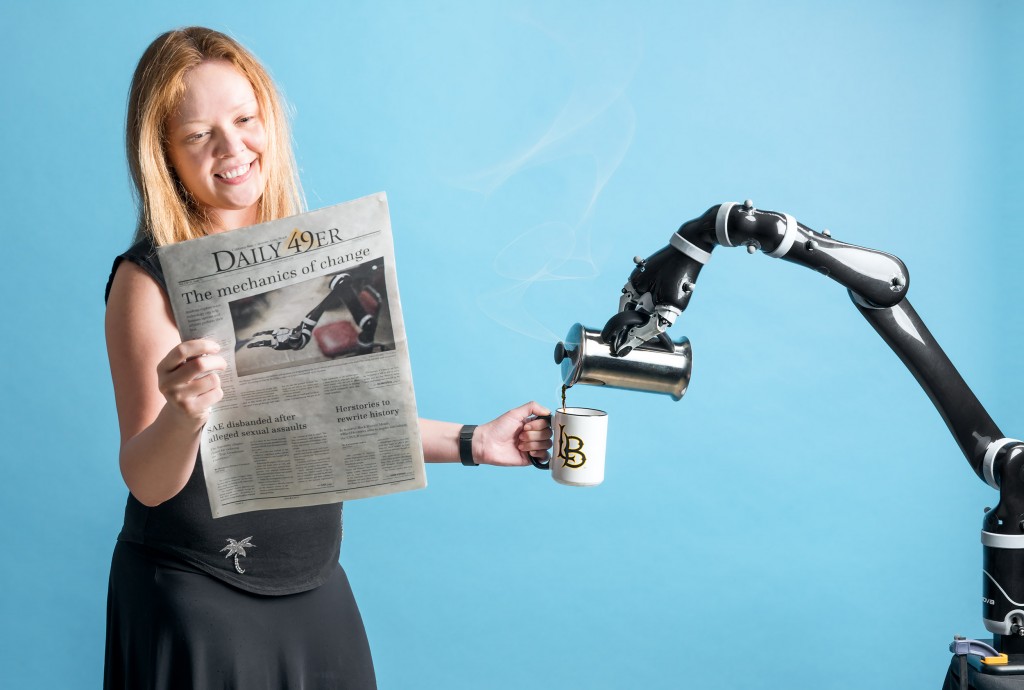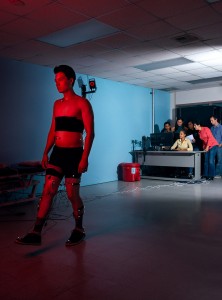Personalized Medicine
Dr. Forouzan Golshani is on a mission. As dean of the College of Engineering for the past nine years, he is determined to clear the cloud of confusion about engineering as a career choice and instead expose it for its phenomenal impact on everyday human health, happiness and safety.
He has engaged four researchers who are attempting to change the way we experience everything from medical diagnoses, physical therapy, flying while disabled, and healing from heart disease.
“The general misperception is that engineers simply fix things or work with their hands,” said Golshani, a U.S. and international patent holder. “In reality, we are problem solvers. Our joy is in finding solutions for people’s problems and making those solutions applicable to the general population.”
Freedom to Fly
Those with disabilities could soon have Golshani and doctoral student Massoud Saleh to thank for easier and more dignified air travel. The pair is working on an apparatus to convert an existing aircraft seat to a wheelchair. The removable wheeled seat, currently in the testing phase to meet Federal Aviation Administration (FAA) regulations for crash worthiness, is used to discreetly transfer people with mobility impairment from the terminal to the aircraft without the need to be lifted to another seat inside the airplane cabin.
The project, part of a comprehensive “person-centered design” initiative, is a joint effort between CSULB and Arizona State University, and is primarily funded by a $3 million grant from the National Science Foundation.
“We’re in the right part of the world for this. There is such a huge presence of aerospace industry in Southern California, and we’re talking with the right folks,” Golshani said. “Once we pass the research and perfection of design stage, we will have a very easy time seeing this new technology deployed.”
Healing The Heart
Another innovation aimed at improving human health is being studied under the leadership of Dr. David Stout, an assistant professor in the College of Engineering. While Stout’s background is in aerospace engineering, a personal experience with a friend born with a heart defect led him to pursue a biomedical project that he calls a “heart patch.”
“I realized I wanted to make an impact on society,” Stout said. “If we can fly to the moon, surely we can solve what appears to be a simple problem in the heart. That was my motivation in moving from the aerospace to biomedical world.”
Stout, a 2010 undergraduate and Ph.D. graduate in biomedical engineering from Brown University, began his heart patch research nearly four years ago and is now joined in his studies by undergraduate and graduate students Gina Vimbela and Ajay Shirolkar. The project was originally funded through the National Science Foundation and continues today through CSULB – funded institutional grants.
Stout’s patch suggests that the dead heart tissue experienced after a heart attack can essentially be brought back to life by applying a scaffold-type material composed of carbon-based nanofibers and a biodegradable polymer approved by the U.S. Food and Drug Administration (FDA). The patch mimics healthy heart tissue and, when combined with human stem cells, helps generate what Stout refers to as “native artificial tissue.” This new conductive tissue functions as a permanent bridge over the dead tissue – supporting electrical systems and allowing the heart to become stronger.
“When someone has a heart attack, it’s a pretty big deal,” Stout said. “Right now, you would go to the hospital and receive a stent, balloon or bypass surgery followed by a lot of medications and encouragement to eat healthy and exercise. But the problem of the dead tissue remains. The heart continues to get weaker over time, causing more than 50 percent of patients to have a recurrent heart attack within five years.”
While the FDA approval process could take up to 10 years, Stout believes his innovation will eventually provide a solution, rather than a suppression of symptoms, for heart attack victims.
“Our goal is to create a fully functional heart Band-Aid that can be surgically inserted into patients so they can have a healthy heart again,” Stout said. “Numerous laboratory tests indicate that the heart patch is performing just as we’d hoped, so we’re very encouraged about one day putting it to use in the hands of cardiologists and thoracic surgeons.”
A Measure Of Movement
When it comes to joints prone to osteoarthritis, there is one CSULB assistant professor that is on track to help physicians and physical therapists achieve a better scientific understanding of body movement. This would be possible through the development of a real-time visual feedback framework for posture and motion correction.
Dr. Emel Demircan, director of the Human Performance and Robotics Laboratory, uses musculoskeletal modeling and motion analysis to improve quality of life by demonstrating cause-and-effect relationships in persons with movement disorders and by predicting the effectiveness of proposed surgical and rehabilitative treatments.
“My objective is to develop algorithms to enhance human health,” said Demircan, who earned her Ph.D. in mechanical engineering from Stanford University in 2012. “I use tools from different disciplines, like biomechanics, robotics, neurosciences and machine learning. My hope is to see our framework in action in several clinics and hospitals.”
Imagine an individual with kneepain seeking treatment from a physical therapist. Using Demircan’s technology, the patient wears sensors on the leg and is asked to perform a task, like walking. While walking, the sensors collect data and the framework provides real-time visual feedback to the patient and therapist. They can observe what muscles are activated and better understand the problem with the motion or joints to make real-time corrections for better posture and motion trajectory.

“Many treatment plans are basically trial and error right now,” said Demircan, who is joined in her study by undergraduate and Ph.D. students Keaton Nishimi and Elnaz Lashgari. “What we bring extra, here, is a scientific understanding of the disease. We are able to tell the therapist what’s going on inside the body, how much force is being put on the knees when walking, and how much the muscles are activated. If surgery is needed, the real-time framework can predict the outcome of the procedure as well. The system is highly subject specific and can scale the model to each patient based on differences in physiology, mass and muscle capacities.”
Demircan said there is a lot of work left to do, especially in the area of data collection from different age groups, but she hopes to see the project completed and ready to deploy in a clinical setting within four to five years. For now, her studies continue to be funded by institutional grants and CSULB Alumni Association funds, as well as the NIH BUILD grant.
“This framework can be generalized for any disease,” Demircan said. “In addition to typical bone and joint problems, we are optimistic that this model will also be helpful to people with Parkinson’s disease and cerebral palsy, as well as to older adults who are at high risk of falls.”
Application of Artificial Intelligence in Medicine
Rounding out the list of innovative engineering work going on is a research project that sits at the intersection of computer science and medicine. Dr. Shadnaz Asgari and her team of undergraduate and graduate students are applying artificial intelligence and signal processing to medical data in an effort to help physicians improve the diagnosis and treatment of patients at the bedside.

Consider a patient in a hospital intensive care unit who is monitored around the clock for vital signs, such as body temperature, pulse, respiration rate, blood pressure, intracranial pressure and more. A massive amount of data is continuously collected for the patient, yet the doctor only receives a snapshot of that data based on 10 or 15 minutes of monitoring that occurs just before meeting with the patient.
“When a physician gets a printout of the last 10 minutes of data, he usually eyeballs it and tries to figure out, based on the pattern he sees, if he can make better decisions for his patient,” said Asgari, a Ph.D. graduate in electrical engineering from UCLA. “This isn’t really effective because he is missing a huge amount of information. Our technology looks at all of the data through sophisticated programming and detects hidden patterns that may be helpful to the doctor in the present, or even as a predictor for what is going to happen in the future.”
The project, one of several exploring the concept of biomedical pattern recognition, is currently in the proof of concept stage but shows great promise for application in the clinical setting within five years.
“My goal is to revolutionize the way patients are diagnosed and treated by improving the quality of clinical decision support made available to the physician,” Asgari said. “And, if even only one student reads this and is inspired to help people through computer science, that would be the best reward for me.”